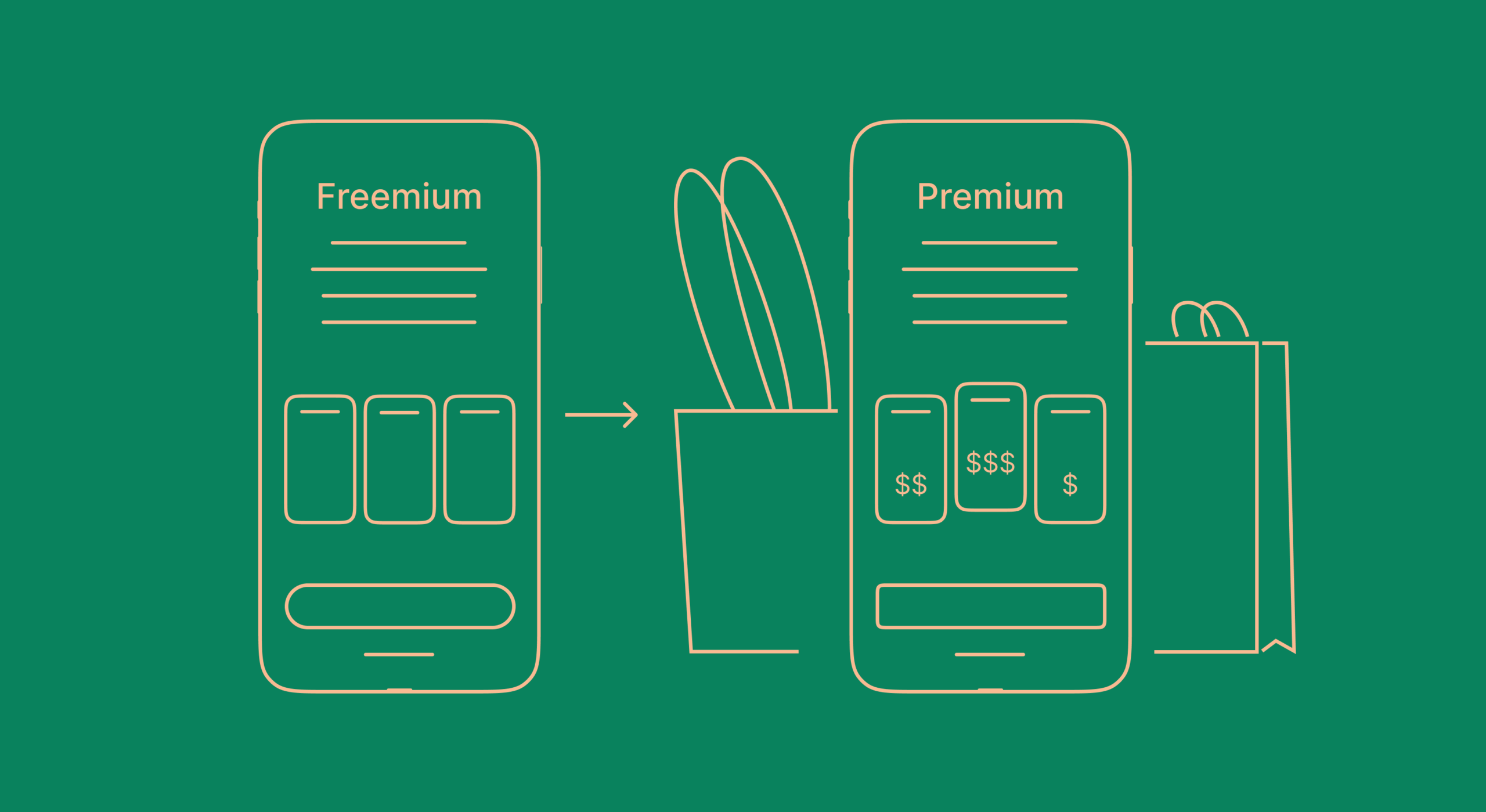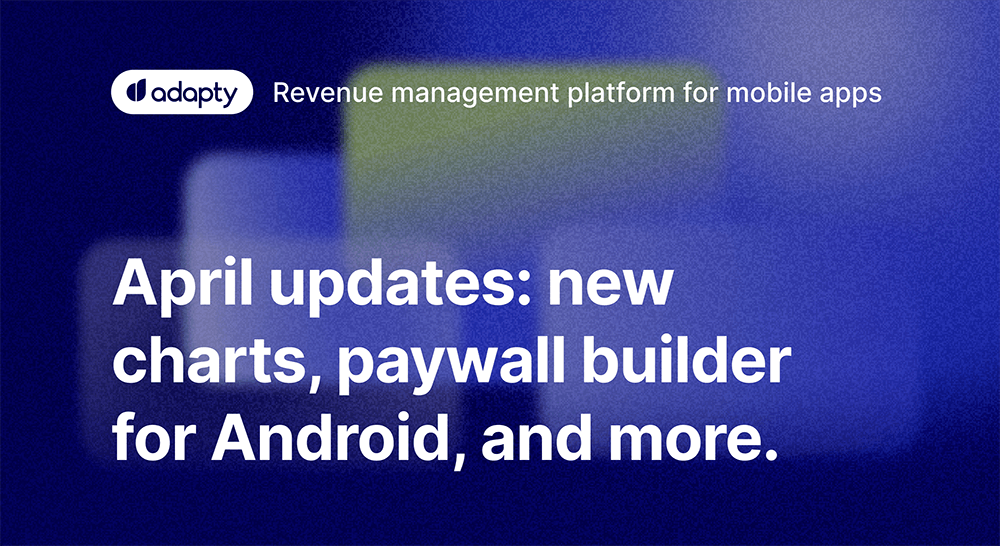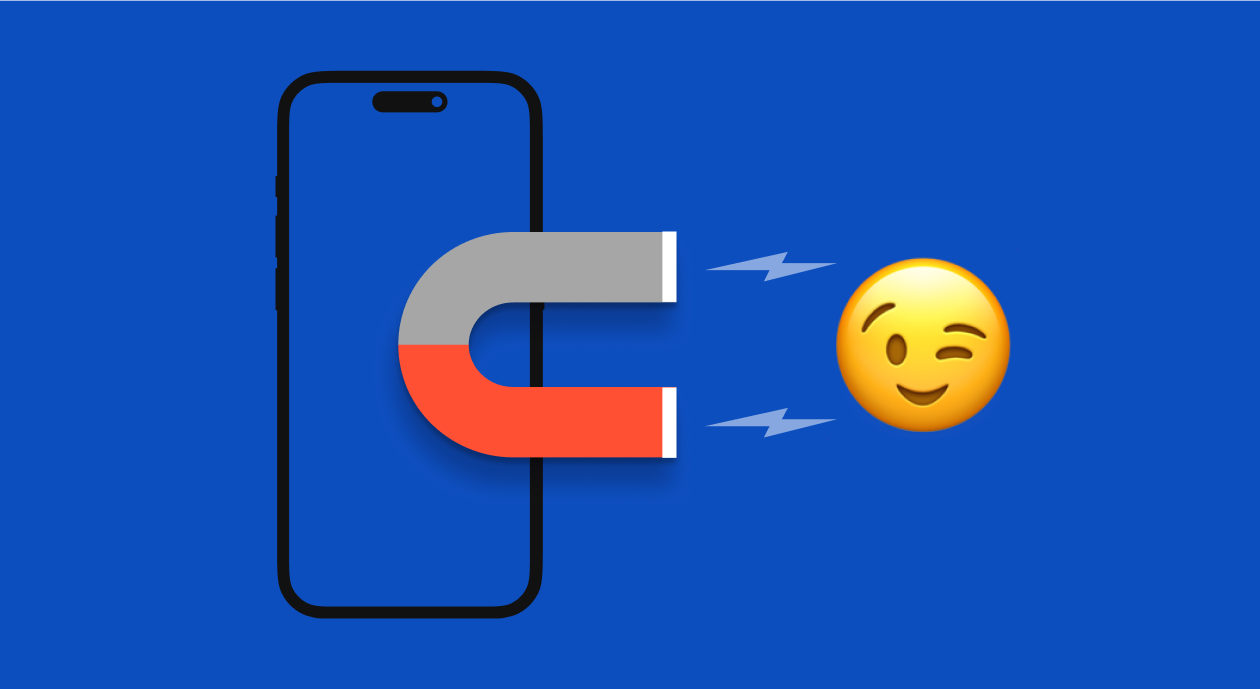The app market is expected to hit $542 billion by 2026. It’s estimated to reach US$420.70bn by 2022 alone. One revenue stream that consistently comes at the top in all these projections is app subscriptions.
Between 2014 and 2017, Google recorded a 10X growth in app subscription revenues in Google Play. Over the years, app subscription revenue has only continued to grow. A recent study reports that subscriptions account for 82% of all revenue generated by non-gaming apps. In line with this, a 2020 data.ai (formerly App Annie) report attributed 79% of Google Play’s top U.S. non-gaming apps’ revenue and 94% of the same on the iOS app store to subscriptions. Yet another study by SensorTower discovered that app users are increasingly turning subscribers, driving substantial revenue for app publishers. In 2021, the top 100 subscription apps made $18.3 billion (up 41%) from $13 billion the previous year.
Since app conversion rates average 1-2%, we wonder: What exactly gets free mobile app users to get to the other side of the paywall as subscribers? Especially given that subscribers need to commit to weekly, monthly, or annual payments, unlike simple single in-app purchases. Let’s find out.
Unlocking access to additional app content
When Google spoke to 2,000 Android app subscribers across the U.S. and U.K. to understand what got them to subscribe to an app, about one-fourth (26%) said they upgraded to a premium subscription to access the app’s full content. So the ability to unlock premium content is the #1 motivation that drives subscriptions.
Exclusive (premium-only) content doesn’t just entice free app users to upgrade but also gets them to keep paying. When apps keep delivering valuable content regularly, 44% of subscribers continue with the premium plans, while 25% cancel if the content doesn’t provide value or is deemed stale.
Content-driven industries (such as health and wellness, news, and entertainment) naturally tend to drive the most conversions by moving valuable content behind the paywall. Still, content is the key conversion tool across all categories:
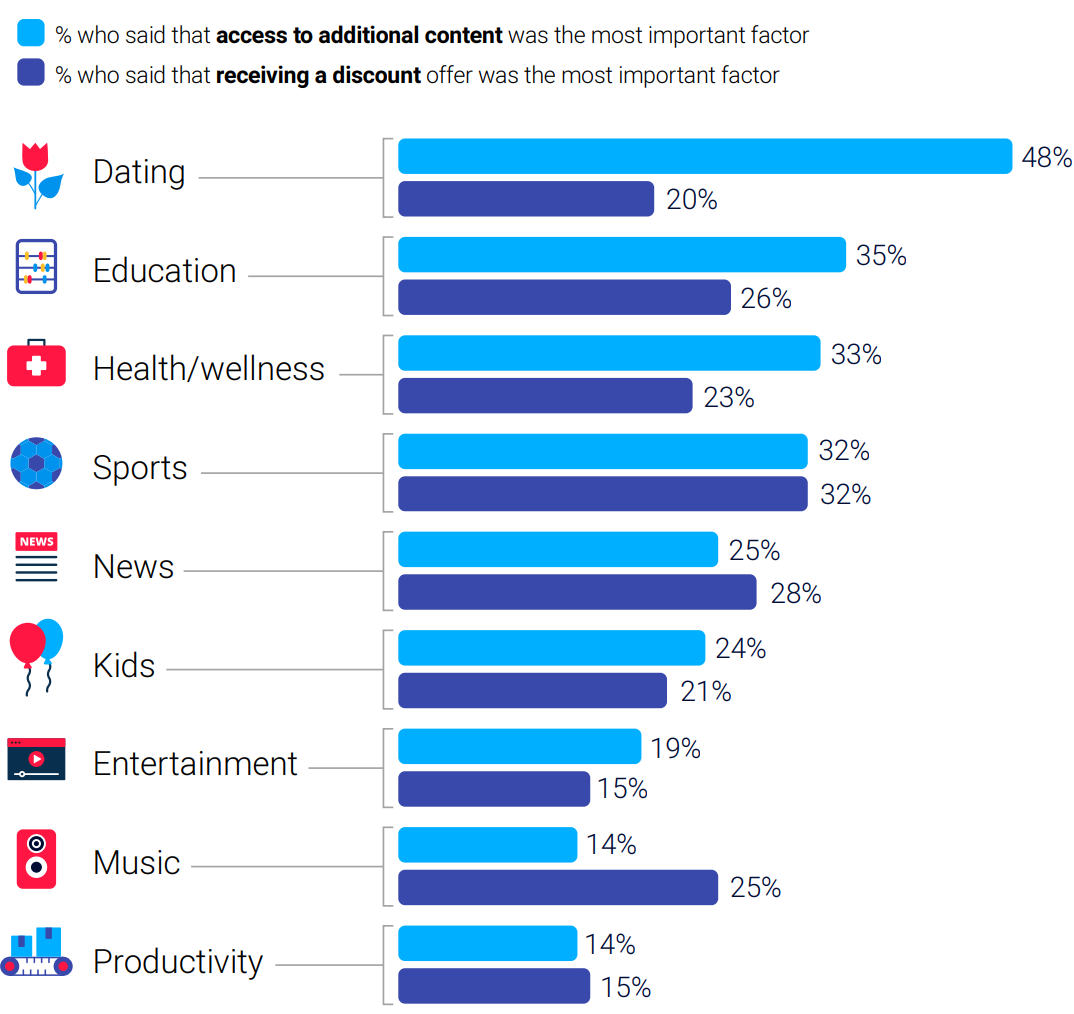
The New York Times app is a classic example. We’ve all hit the publisher’s paywall at some point! Did you know when NYTimes started metering its content back in 2011, it offered 20 free articles a month? Eventually, it lowered the quota to 10. The app now limits free stories to 5 a month. The lesson? Finding the right mix of free and premium content may take some experimentation.


Taking advantage of subscription offers (deals and discounts)
In the same study, a solid 23% of mobile app users mentioned that they ended up subscribing to an app because they received an excellent upgrade offer:

Now, of course, most users who take advantage of a good deal on an app do so to access its premium content, unlock more features, or get rid of ads.
However, it’s important to note that even new free app users (who perhaps haven’t even explored an app fully) can still upgrade if they receive an offer they can’t refuse. A participant in Google’s survey recalled how they upgraded simply because there was an offer: “I had signed up for a free trial because I got some kind of offer on it. I didn’t even really know what it was all about but my kids ended up loving it so I kept it and still pay a subscription for it.”
Said another way: Users that know the value of your app but aren’t paying subscribers yet may only need a good nudge in the form of a good offer to upgrade. And new users? Well, they can go pro right from the go if they see an irresistible offer.
So what does a good offer – more so the “intro” offer – look like? Many things:
- The discount itself (and, of course, your app’s base pricing)
- The way you present it (the layout)
- The messaging (offer copy)
As you can tell, there’s no one right way to approach these. The best way to find out what works for you is to run A/B tests to discover offers, layouts, and messaging that resonate with your subscribers. To start with, your general pricing should be right, too – yet another thing you can determine with testing.
[In our guide on paywall testing, we talk about testing these deal elements in detail. Check it out.]
Wanting to extend post the trial
Here’s one for app publishers that publish paid apps – apps that charge users/subscribers to use them. In this case, users must subscribe (to premium plans) in order to continue using an application.
Even though paid apps only make up a small part of the mobile app ecosystem, subscribers happily pay for them if they deliver value. In Google’s study, 17% of subscribers admitted to subscribing as they ran out of the free trial. You can attribute this partly to the fear users have of losing the progress they might have made on the app during the trial.
If you’re a publisher into paid apps, know that trials are your best conversion tools. When done right, running fully-featured free trials can act as an excellent subscriber acquisition tactic as it gives users a feel of the app before committing to a plan.
Let users enjoy complete, unrestricted, and ad-free access to your app for an optimal length, and then pitch the perfect upgrade offer. Experiment with different trial periods to find the most conversion-friendly one for you. Consider 7-, 14-, or 30-day trials to see which one allows users to get a really good experience with your app – enough to encourage subscriptions. Test multiple upgrade plans – like giving two months free if users sign up for a full year or additional discounts on longer commitments – to find your “winner.”
[Check out how Adapty’s SDK can help you implement hassle-free free trials inside your app.]
Looking to enjoy ad-free experiences
Revenue from in-app advertising spending is set to hit the $400B mark. Both free and freemium app publishers rely heavily on in-app advertising.
App users also don’t seem eager to pay for ad-free experiences. An old study (from 2015) found that 67% of app users won’t pay anything for removing ads. Barring a few exceptions – apps like Spotify, Amazon Prime, and Youtube, to name some – users simply aren’t keen on paying a premium for ad-free app access.
That said, freemium app users still opt for premium plans to avoid ads — even if it’s only a small percentage of users (about 6%).
It’s important to note, however, that given the recent awareness around privacy and how many advertising solutions have been found to rampantly profile and track users, this number is bound to have improved.
But anyway, by itself, an ad-free experience may not be incentive enough for upgrading for most apps. Yet it’s an essential for premium app subscribers. Most premium apps actually advertise ad-free experiences prominently on the paywall. Tumblr is one of the latest apps to launch a premium ad-free subscription plan: (Even if you’ve enjoyed the weird ads you saw on the platform – who hasn’t! – the ad-free version has its share of takers.)
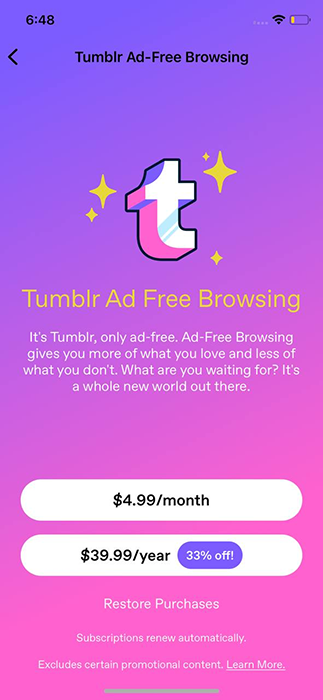
Unlocking app premium (more tools, features, and access!)
Another 20% of app subscribers commit to premium subscriptions if they want to unlock premium tools, features, and access that are available only in the paid version:
- Adding offline access drives about 6% of premium app subscriptions. If your app subscribers will find offline access reason enough to upgrade, build your app with an offline-first mindset.
- Unlocking additional app tools/features drives yet another 6% of upgrades.
- Enabling app access on multiple devices is another reason about 6% of app subscribers upgrade.
- Bringing on additional users also drives premium app signups (about 2%). If your research indicates that your users value collaboration, this is something you want to add post the paywall.
Offering a meaningful freemium app model holds the key here. As author Vineet Kumar explains in this HBR piece, if your app offers 20 features and you make 5 available for free and out 15 after passing the paywall, you need to ensure the free ones are good enough to attract new installs while the 15 locked features make compelling reasons for upgrading.
As Kumar suggests, if your freemium model isn’t attracting new users, you’re probably not offering meaningful free features. Additionally, if you’re drawing tons of new users but not seeing upgrades, you may be offering too much in your free version, so users don’t need to upgrade.
You don’t want either to be the case with your freemium mobile app. Identify the features that will drive traffic (and installs) and the ones that users will pay for. Getting this “balancing act” right will lead to new subscribers. Keep Kumar’s math in mind: “you would do better to convert 5% of 2 million monthly visitors, for example, than to convert 50% of 100,000 visitors.” This holds as the freemium acquisition model hinges on your ability to generate traffic.

Paying for privacy
App data can tie to something much bigger. Take the period tracking app segment, for instance. Following the U.S. Supreme Court’s decision to criminalize abortion, app users went into a tizzy, with Flo – the leading app owing 47% of the market – losing users and a hike in adoption of apps like Stardust. Why? Privacy.
Patterns in app switching show beyond doubt how app users value privacy-first apps. Understandably so, no one wants to be snooped on and have their mobile phones turned into surveillance devices that advertising networks or agencies can tap.
In the research paper (Can you pay for Privacy? ), 6% of app users who chose to download paid apps when given a choice between getting paid and free versions stated that they went pro because of the perceived privacy and security risks in free apps. One participant mentioned how premium apps looked less susceptible to “data mining.” Another person said how they would review the app for its permissions while adding that “paid apps are safer.” App users, in general, shared that they expected using the free version would mean sharing data with several parties.
Even with app stores trying to give users more control over what data they share and push publishers to move toward consent-based monetization, delivering privacy-friendly app experiences remains a challenge. It is not uncommon for many apps to (even indiscriminately) ask for access to your contacts, location, storage, and even to your microphone and camera.
If you want to leverage this “pay-for-privacy model” for driving subscriptions, you need to prioritize your users’ privacy. It requires you to follow lots of privacy-preserving practices. With this model, your subscribers “expect” you to 1) encrypt their data, 2) protect it from breaches, 3) comply with privacy laws and regulations, 4) maintain transparency around your data collection practices, and 5) give them granular control over what data gets collected.
You must also communicate the same through your messaging. Here’s how Stardust puts it:
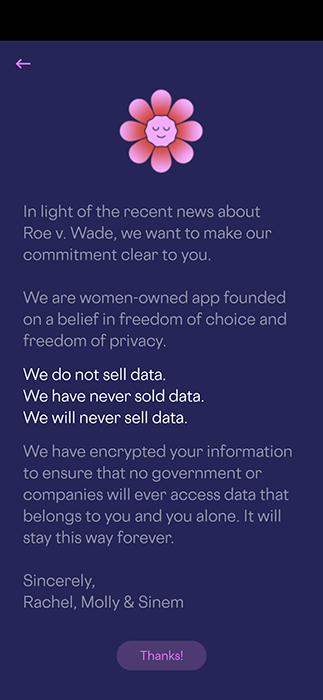
Wrapping it up…
As you just saw, converting free app users into paying subscribers, sometimes, simply comes down to showing the right upgrade offer. Actually, if you review the above list, you’ll see that even if you get all the other things right (balancing free vs. premium features, offering high-value premium content, offering smooth ad-free experiences, embracing privacy-friendliness, etc.), it’s still what users see on the paywall that gets them to convert.
If you’re considering adding subscriptions to your app monetization mix or are looking to improve your free-to-premium conversion rate, get your paywall offer right.
And how do you find out what works for you? Test. A/B test all the stuff on your mobile app paywall right from your offer to your copy and layout. Industry benchmarks can only help so much. Check out how Adapty can help with your paywall A/B testing.
About Adapty: Adapty brings everything you need to implement subscriptions inside your app. Adapty’s SDKs also let you set up hassle-free trials and run A/B tests on your paywall. Find out how you can grow your app business with Adapty.

